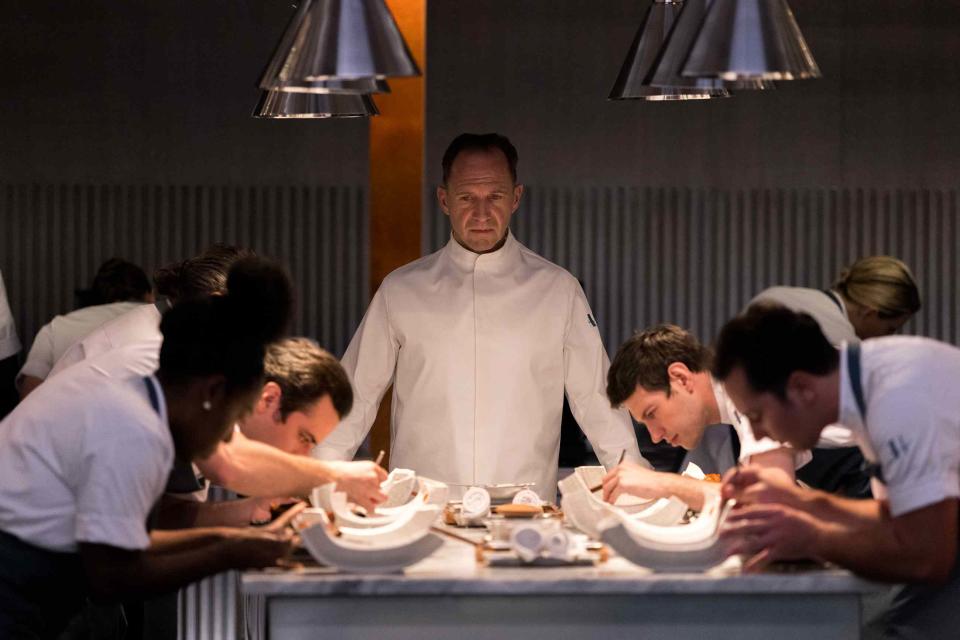How Much Would You Be Willing to Pay for the Meal of a Lifetime?
The new movie "The Menu" takes a savage bite out of chef-worship culture.

Eric Zachanowich / Courtesy of Searchlight Pictures
In The Menu, the newest movie from Searchlight Pictures, edge-of-your-seat suspense comes from something familiar to anyone who has worked in or dined at a restaurant — the dynamic between the kitchen and the guest.
At Hawthorne, the ultra high-end restaurant located on a middle-of-nowhere island akin to Willow’s Inn on Lummi Island or Cornelius Sjømatrestaurant in Bergen, Norway (which writers Will Tracy and Seth Reiss say inspired the film), 12 guests are able to indulge in an exclusive multi-course dinner from the mind of the creative genius, chef Julian Slowik, played by a menacing Ralph Fiennes. But the meal comes at a lofty price: $1,250 per head (wine pairings and tips included) and — just maybe — your very existence.
:
Aside from Margot (Anya Taylor-Joy), who was invited as Tyler’s (Nicholas Hoult) last minute date, each of the diners represents some of the worst types of people to serve. There’s a prolific food critic who has the power to shut down a restaurant in a week with her thesaurus-worth of flowery words like “fiendish” and “vlasik” (which apparently means oceanic?). There’s a table full of finance bros who “know the owner,” and are ready to use that to their advantage at any moment. There’s a couple who have been to Hawthorne so many times that the entire experience feels like an everyday occurrence. And then there’s Tyler, the ultimate foodie, the Chef’s Table super fan. He’s convinced he knows just as much about food as any James Beard Award winner even though he’s never worked a single day in the restaurant industry.
Each of these guests were hand-selected by Slowik to experience the dinner of a lifetime. Like many similar tasting menus, each of Slowik’s dinners have a specific purpose or theme, and part of the fun is trying to figure out exactly what that theme is. Well, it doesn’t take long for the guests to uncover this theme, and its horrific implications.
:
Slowik uses his menu as an act of vigilante justice. He is tormenting the very souls who strip the joy from cooking, and he’s having a great time kicking them while they’re down. And then there’s the final course which, for Slowik, adds to the drama of “the menu,” though in reality, it reflects the powerful chef’s state of mind. He is both godlike and utterly depressed. He walks around the kitchen with full confidence and command. He is praised by food lovers around the world, not to mention his entire kitchen. But after years of being put on a pedestal and creating sterile, albeit complex dishes, Slowik no longer enjoys cooking. Love, the “most important ingredient,” in the words of one diner, is neither in his food nor his restaurant.
The back of house clearly knows what they’re doing;The Menu’s director, Mark Mylod, purposely cast cooks who had kitchen experience. They appear robotic, exclaiming “Yes, chef!” and “I love you, chef!” on command as they pipe gel and tweeze microgreens. And there’s reference to extreme toxicity long before this night began. Slowik’s two sous chefs were both tortured in horribly true-to-life ways. Jeremy (Adam Aalderks) appears to have been constantly berated by Slowik for being good, but not good enough — never good enough to reach Slowik’s level of acclaim. Katherine (Christina Brucato) was given the treatment that so many women chefs are forced to endure in a male-dominated kitchen. Slowik eventually gives Katherine an opportunity for retribution, but it’s done in front of an audience in a rehearsed, manufactured setting, reminiscent of a PR-driven apology.
:
And then there’s the food. The meal at Hawthorne, objectively, looks gorgeous. A lot of that is thanks to chef Dominique Crenn’s food styling as chief technical consultant for the film and the directorial assistance of David Gelb, creator of Chef’s Table. Slowik and his team serve fresh scallops, caught that afternoon, surrounded by a landscape of seaweed and smoke. There’s an amuse bouche of a single oyster, covered in a foamy mignonette and citrus caviar. There are deconstructed tacos with tortillas made from local corn which is obviously nixtamalized in-house.
These first couple of courses bring the more enthusiastic guests like Tyler to tears, but Margout, the outsider of the group, is never wowed. It’s that ambivalence that shakes Slowik to his very core and distracts him from the flow of “the menu,” making him completely desperate to please her.
:
For a moment, Slowik is able to reconnect with why he chose to become a chef in the first place: cooking good food that makes people happy. But it’s not enough. He’s still committed to following through with his menu.
After nearly two hours of observing how obnoxious the guests were, it’s hard to not root for Slowik, to almost idolize him as his kitchen and devoted fans do. But it’s that very power, that ability to so easily move a group of people with the clap of his hands, that proves so dangerous onscreen and in reality. It's something that we have seen time and time again as masochistic (though outwardly charismatic) celebrity chefs have created hostile work environments that ruin the lives of those around them. The kitchen team could have fought against their military-like brigade training to say “no, chef!” The guests were wealthy enough to skip out on the meal as soon as the evening felt off. Instead, they all decided to stay for dessert.

